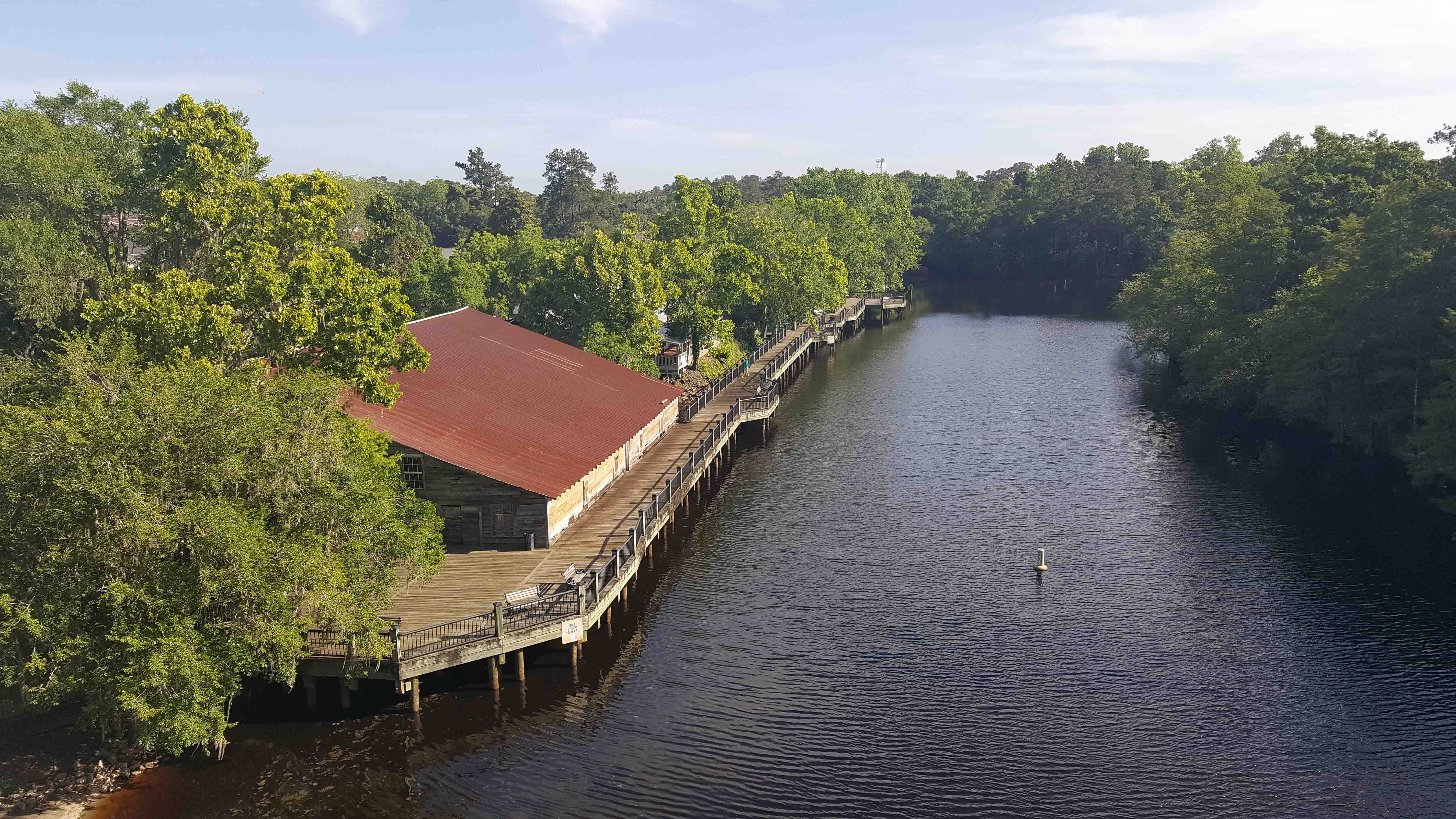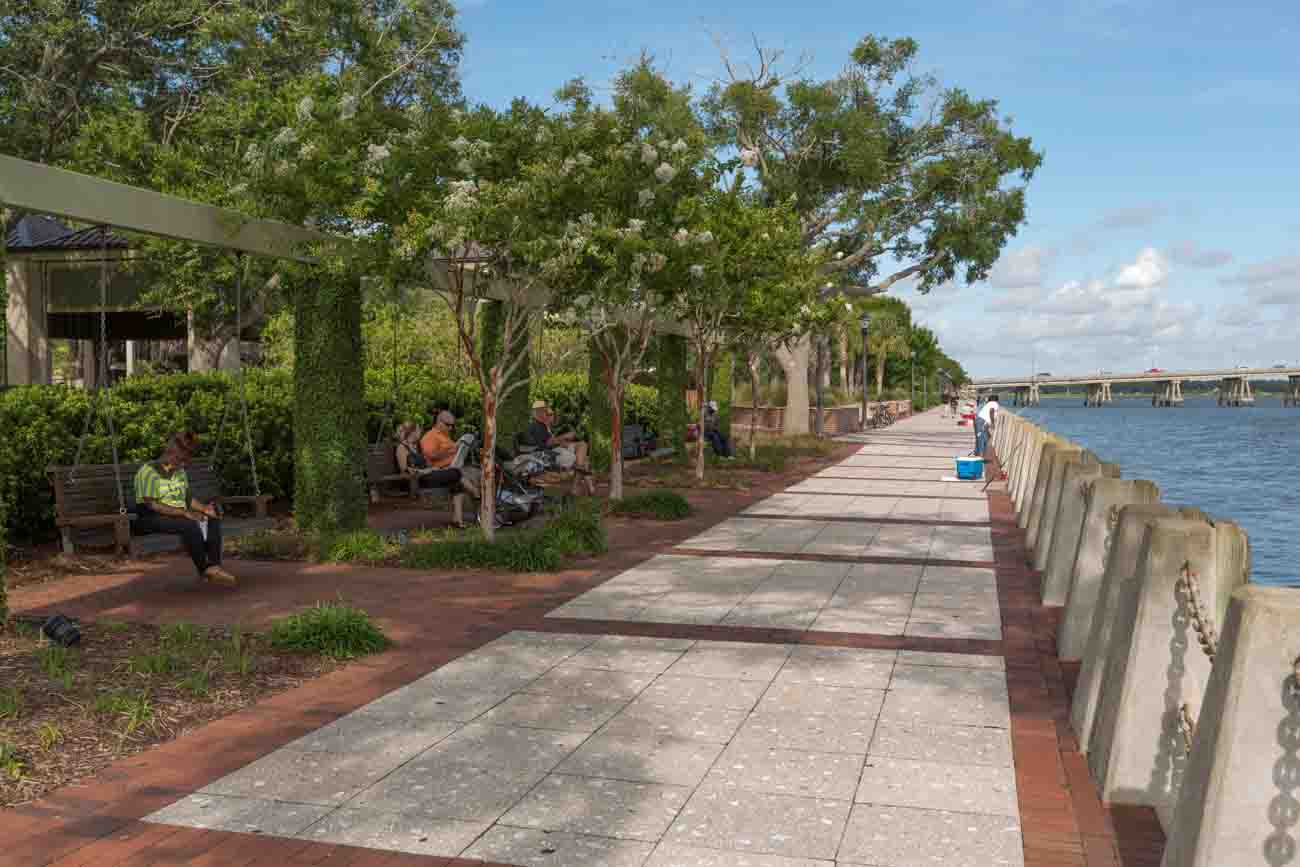Visitors to the City of Conway may stand just a block from the Waccamaw River, not knowing how close they are.

The City of Conway's three-phased riverwalk project began in the 1990s and now includes a riverfront park, arboretum and boat ramp. Photo: City of Conway.
But that is going to change. City officials are working through the permitting process with the U.S. Army Corps of Engineers to build a new 400-foot boardwalk section that will connect its river boardwalk to downtown. This is part of Conway's master plan to bring cohesiveness and public access to both areas.
Economic development plans, meanwhile, continue on a parallel track. Discussions in 2016 with the Burroughs Company, which owns land near the river, led to a public-private partnership with the city. The company agreed to donate real estate to the city. In exchange, the city will make infrastructure upgrades, including parking facilities, landscaping and utilities, to the benefit of the public and the company's remaining property and future development.
One restaurant, located in a historic building, is attached to the Conway Riverwalk, while a second building was recently sold and is expected to include a restaurant. Four new building sites near the riverwalk will include a hotel and other businesses, said Conway City Administrator Adam Emrick.
City officials used hospitality taxes to build the walkway and the park.
The city has a full-time grounds department that maintains the riverwalk and the surrounding landscaping. The city also installed wireless security cameras and has added a 100-foot transient boat dock on the riverwalk, the third dock on the promenade, he said.
The latest developments cap decades of efforts by city officials to maximize the river's benefits for residents, visitors and businesses. Three phases of construction from 1993 through 2009 brought about the Conway Riverwalk, a source of pride for residents. Locals walk along it every day, including downtown workers who use it to grab some lunchtime exercise.
"The riverwalk is the physical tool that allows the river to be the experience," said Emrick. "When the riverwalk was constructed, the river, again, became part of who we were as a city and as a community. A renewed interest in the river as an amenity was immediate."
Conway illustrates just one way South Carolina cities are leveraging their natural water resources to enhance the quality of life, improve recreational offerings, and drive economic development and tourism. From the Conway Riverwalk to the new Pacolet River Passage Gateway Project to the Atlantic coast, municipal officials recognize the economic and quality-of-life benefits of their waterbodies.
The City of Beaufort's Waterfront Park is undergoing improvements to enhance the seaside experience of residents and visitors.

The public enjoys the promenade at Waterfront Park in the City of Beaufort, which is undertaking underwater infrastructure repairs and constructing a new day dock. Photo: City of Beaufort.
"Everyone wants to be by the water," said Linda Roper, Beaufort's director of downtown operations and community services.
"All of our residents and tourists come down (to Beaufort's Waterfront Park) regularly just to spend time on the water and feel the sea breeze, to sit on a swing and enjoy the salt air. Even in the summer, when you're on the water, it feels cooler."
Upkeep and repair
While it's been an obvious success with locals and visitors, the Conway Riverwalk has seen its share of havoc wreaked by Mother Nature. In three of the last five years, the riverwalk was under water for at least a month as the flood of 2013, Hurricane Joaquin in 2015 and Hurricane Matthew in 2016 swamped Conway. This year, as the city begins a board replacement program of the riverwalk's decking, city officials are considering using rot-resistant composite board.
The City of Beaufort got an early start on waterfront revitalization, as it started leveraging its location on the Beaufort River in the late 1970s, when former Mayor Henry Chambers pushed his vision for a waterfront showplace everyone could enjoy. The city worked diligently to secure state and federal grant funding to acquire property, work with local businesses and build the park.
"It made Beaufort thrive. It took some years, but the economic impact was huge," Roper said. "It started shifting into seeing different types of businesses along the water. And today we have restaurants with dining on Waterfront Park. They have taken advantage of being on waterfront property that's absolutely gorgeous."
Beaufort spends about $300,000 each year for daily maintenance of the park. The waterfront park went through a multimillion dollar restoration and partial redesign in 2006, according to Roper. Now, the city is repairing and replacing the pilings under the promenade, which has been at the water's edge since the 1970s. The project includes a new day dock attached to the park to allow boaters to arrive by water, tie up their boats and enjoy downtown Beaufort.
Destination ahead
In the Town of Pacolet, the Pacolet River is already a valuable asset to the community but will soon become more of a gathering spot, according to Mayor Mike Meissner. The $1.47 million gateway project will include a park and recreation area along the south side of the river, featuring trails, walkways, river overlooks, swings and benches. The project also includes construction of a roundabout to replace the intersection near the new park.
"Right now, it's a place with some grass and parking lots. It's not a place to hang out or sit around and enjoy," Meissner said. "But when we bring in this greenspace and fix the road, we're going to make this a destination."
The town is in the process of putting the project out for bids, with the work expected to take six to nine months to complete once construction begins.
"We're going to have a waterfront park right there for the whole community. In the long term, we want to add some trails. The idea is that it's not only an asset to community members, but it's also an asset to bring in tourists," Meissner said. "It's going to be another asset we'll have for our community and the surrounding communities."
The area's connection with the river goes back centuries. Long before textile mills set up on the river, it was home to one of the largest Native American soapstone quarries in the country.
"The Pacolet River is not too far from urban areas, so if you live in the City of Spartanburg, you don't have to drive all the way to Asheville or Columbia to do stuff along the river," Meissner said. "It's just 10 minutes down the road."
Factor in public access, heavy usage
They've been there — They've done it. And along the way, city officials have gathered lessons about enhancing the public's access to rivers, lakes and shorelines.
Linda Roper, Director of Downtown Operations and Community Services, City of Beaufort
Keep the public first. Roper suggests that towns looking to take advantage of their water features develop a plan that combines efforts to encourage business creation on the waterfront with steps to make sure the area stays open and accessible to the public.
"Whether people want to touch their toes in the water or not, you need to understand that if you build and allow unfettered access to the water, it brings economic development. Stay the course, don't limit access," Roper said.
"It all should be public. You want businesses to be able to use it, but you don't want them to overtake it. Once you build it, they'll come."
Adam Emrick, City Administrator, City of Conway
The City of Conway's 1½-mile river boardwalk invites residents and visitors alike to enjoy the beauty of the Waccamaw River.
Plan for heavy usage and expect to replace sections of boardwalk.
Expect your waterways to flood. Be willing to close amenities to the public when they are unsafe, and expect damaged infrastructure to surface after the waters recede.
Include features that will make perfect stops for photographs along your waterway. In Conway, the riverfront serves as a popular backdrop for high schoolers posing for prom photos. Build features into the infrastructure that reflect the character of your city, so that people can identify where the picture was taken without the need for words.
Make the waterway the showcase for your city, but make sure that it does not detract from your existing downtown or business district. Coordinate plans at the outset to tie the waterway amenities together with the downtown, or city officials will later spend years trying to figure out how to do it.
